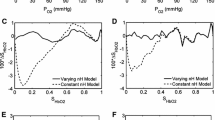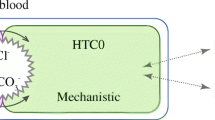Abstract
The action of respiratory and metabolic acid-base disturbances on the O2-Hb affinity was studied in rabbits and cats. Blood samples of both species were exposed to in vitro pH-changes, which were either achieved by variation ofPCO2 (2.8–8.3 kPa) at constant lactic acid concentration, or by addition of lactic acid (5–14 mmol·l−1) at constantPCO2. ThePO2 at halfsaturation (P50) and the Hill'sn were determined from O2-Hb dissociation curves (ODC) in a range between 20 and 80% SO2. Under standard conditions (T=331 K,PCO2=5.33 kPa, pH=7.4), the average P50 value was 4.66±0.05 kPa in rabbits, that is slightly higher than reported by others, and 5.17±0.03 kPa in cats. The average values of Hill'sn were 2.91±0.02 and 2.95±0.03 for rabbits and cats, respectively.
When plasma pH was varied by CO2, the resulting classical CO2 Bohr factor φCO2=ΔlgP50/ΔpH50 was distinctly higher in cats (−0.560±0.006,n=25) than in rabbits (−0.504±0.014,n=22), although in the latter species being even higher than reported elsewhere. Concomitant metabolic acidosis did not significantly affect φCO2, but shifted the P50 at a given plasma pH to lower values. Substitution of lactic acid with equimolar amounts of sodium lactate left both φCO2 and P50 unchanged.
When plasma pH was varied by lactic acid (LA), the resulting fixed acid Bohr factors φLA were similar for cats (−0.420±0.016,n=21) and rabbits (−0.427±0.010,n=18), and not influenced by additional respiratory acidosis. Concomitant respiratory acidosis, however, shifted the P50 at a given plasma pH to higher values.
The deviation of lgP50 from that under standard conditions (lgP50st) induced by both, respiratory and metabolic acid-base changes, can generally be expressed by Eqs. (1) or (2)
Thereby, the first term considers the total pH-deviation, irrespective of its origin, and the second term represents the metabolic (1) or the respiratory (2) correction.
For practical use and within the physiological range of plasma pH (7.2–7.6), φCO2 and φLA are assumed to be additively linked and to be independent of pH. Once these factors are determined for a given species, together with the buffer capacity for CO2, they provide sufficient data to estimate fairly accurately the position of the ODC. This is particularly important for in vivo conditions where respiratory and metabolic acid-base disturbances often occur simultaneously.
Similar content being viewed by others
References
Arturson G, Garby L, Robert M, Zaar B (1974) The oxygen dissociation curve of normal human blood with special reference to the influence of physiological effector ligands. Scand J Clin Lab Invest 34:9–13
Banchero N, Grover RF (1972) Effect of different levels of simulated altitude on O2 transport in llama and sheep. Am J Physiol 222:1239–1245
Bartels H (1972) The biological significance of the Bohr effect. In: Rørth M, Astrup P (eds) Oxygen affinity of hemoglobin and red cell acid base status. Proc Alfred Benzon Symp IV. Munksgaard, Copenhagen, p 717
Bartels H, Baumann R (1977) Respiratory function of hemoglobin. In: Widdicombe JG (ed) Internat Rev of Physiology. Respiratory Physiology 2, vol 14. University Park Press, Baltimore, p 107
Bartels H, Harms H (1959) Sauerstoffdissoziationskurven des Blutes von Säugetieren. Pflügers Arch 268:334–365
Bauer C (1974) On the respiratory function of hemoglobin. Rev Physiol Biochem Pharmacol 70:1–31
Baumann R, Bauer Ch, Bartels H (1980) Influence of chronic and acute hypoxia on oxygen affinity and red cell 2,3-diphosphoglycerate of rats and guinea pigs. Respir Physiol 11:135
Black CP, Tenney SM (1980) Oxygen transport during progressive hypoxia in high-altitude and sea-level waterfowl. Respir Physiol 39:217–239
Böning D, Schweigart U, Tibes U, Hemmer B (1975) Influences of exercise and endurance training on the oxygen dissociation curve of blood under in vivo and in vitro conditions. Eur J Appl Physiol 34:1–10
Bunn HF, Seal US, Scott AF (1974) The role of 2,3-diphosphoglycerate in mediating hemoglobin function of mammalian red cells. Ann NY Acad Sci 241:498–512
Foëx P (1975) Le rôle de la P50 en réanimation. Bull Physiopathol Respir 11:637–658
Garby L, Meldon J (1977) The respiratory functions of blood. In: Wintrobe MM (ed) Topics in hematology. Plenum, New York, pp 90–92
Garby L, Robert M, Zaar B (1972) Proton- and carbamino-linked oxygen affinity of normal human blood. Acta Physiol Scand 84:482–492
Herbert DA, Mitchell RA (1971) Blood gas tensions and acid-base balance in awake cats. J Appl Physiol 30:434–436
Hilpert P, Fleischmann RG, Kempe D, Bartels H (1963) The Bohr effect related to blood and erythrocyte pH. Am J Physiol 205:337–340
Hlastala MP, Woodson RD (1983) Bohr effect data for blood gas calculations. J Appl Physiol 55:1002–1007
Huckauf H, Schäfer JH, Kollo D (1976) Oxygen affinity of hemoglobin and red cell acid-base status in patients with severe chronic obstructive lung disease. Bull Physiopathol Respir 12:129–142
Jelkmann W, Bauer Ch (1977) Oxygen affinity and phosphate compounds of red blood cells during intrauterine development of rabbits. Pflügers Arch 372:149–156
Kiwull-Schöne H, Kiwull P (1983) Hypoxic modulation of central chemosensitivity. In: Schläfke ME, Koepchen HP, See WR (eds) Central neurone environment and the control systems of breathing and circulation. Springer, Berlin Heidelberg New York, pp 88–95
Kiwull-Schöne H, Gärtner B, Kiwull P (1984) On the seemingly diminished CO2-Bohr effect in hypoxic chemodenervated rabbits. In: Acker H, Leninger-Follert E, Lübbers DW, Goldstick TK (eds) Oxygen transport to tissue, vol V. Adv Exp Med Biol 169:163–173
Kiwull-Schöne H, Ward SA, Kiwull P (1981) The involvement of expiratory termination in the vagally mediated facilitation of ventilatory CO2 responsiveness during hyperoxia. Pflügers Arch 390:63–69
Krall MA, Bristow JD, Welch JE, Metcalfe J (1978) Physiological effects of lowered blood oxygen affinity in dogs. Respir Physiol 33:263–270
Lahiri S (1975) Blood oxygen affinity and alveolar ventilation in relation to body weight in mammals. Am J Physiol 229:529–536
Lenfant C, Torrance JD, Reynafarje C (1971) Shift of the O2-Hb dissociation curve at altitude: Mechanism and effect. J Appl Physiol 30:625–631
Meier U, Böning D, Rubenstein HJ (1974) Oxygenation dependent variations of the Bohr coefficient related to whole blood and erythrocyte pH. Effect of lactic and carbonic acid. Pflügers Arch 349:203–213
Rand PW, Norton JM, Barker ND, Lovell MD, Austin WH (1973) Responses to graded hypoxia at high and low 2,3-diphosphoglycerate concentrations. J Appl Physiol 34:827–832
Reeves RB, Park JS, Lapenas GN, Olszowska AJ (1982) Oxygen affinity and Bohr coefficients of dog blood. J Appl Physiol 53:87–95
Riegel K, Ruhrmann G (1964) Über die Atemgastransportfunktion des Blutes und die Erythropoese junger Kaninchen. Acta Haematol 32:129–145
Scheid P, Meyer M (1978) Mixing technique for the study of oxygen-hemoglobin equilibrium. J Appl Physiol 45:818–822
Severinghaus JW (1966) Blood gas calculator. J Appl Physiol 21:1108–1116
Siggaard-Andersen O (1974) The acid-base status of blood, 4th edn. Munksgaard, Copenhagen, pp 71–80
Teisseire BP, Soulard CD, Herigault RA, Leclerc LF, Laver MB (1979) Effects of chronic changes in hemoglobin-O2 affinity in rats. J Appl Physiol 46:816–822
Turek Z, Kreuzer F, Ringnalda BEM (1978) Blood gases at several levels of oxygenation in rats with a left shifted blood oxygen dissociation curve. Pflügers Arch 376:7–13
Wranne B, Woodson RD, Detter JC (1972) Bohr effect: Interaction between H+, CO2 and 2,3-DPB in fresh and stored blood. J Appl Physiol 32:749–754
Author information
Authors and Affiliations
Additional information
Supported by the “Deutsche Forschungsgemeinschaft”, SFB 114. Preliminary reports of this work have been published in Pflügers Arch (1985) 403 (Suppl): R19
Rights and permissions
About this article
Cite this article
Kiwull-Schöne, H., Gärtner, B. & Kiwull, P. The effects of CO2 and fixed acid on the O2-Hb affinity of rabbit and cat blood. Pflugers Arch. 408, 451–457 (1987). https://doi.org/10.1007/BF00585068
Received:
Accepted:
Issue Date:
DOI: https://doi.org/10.1007/BF00585068




